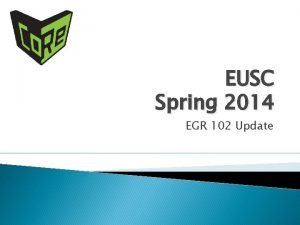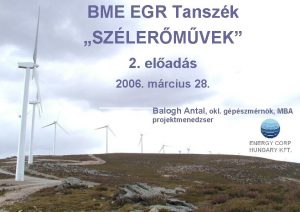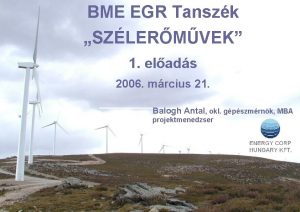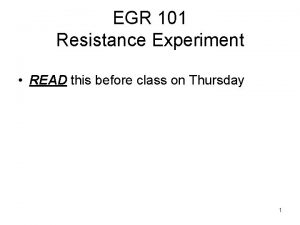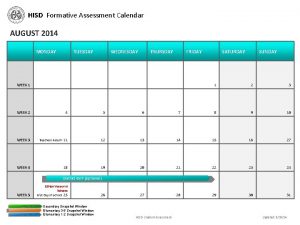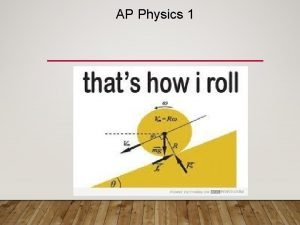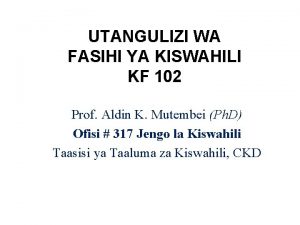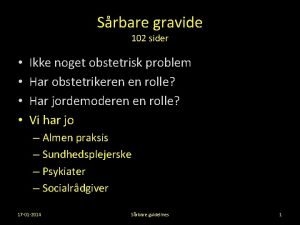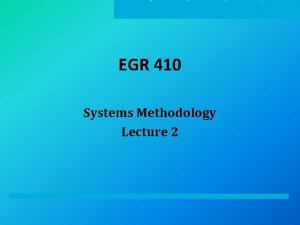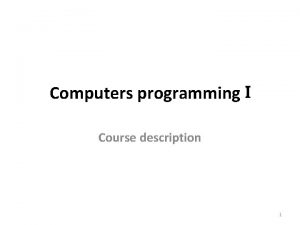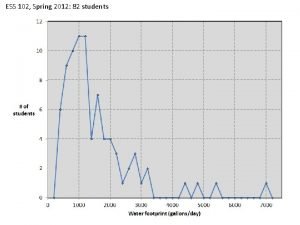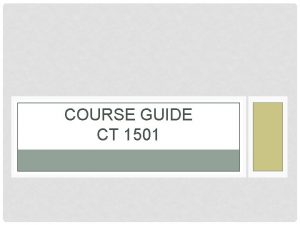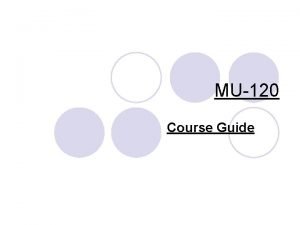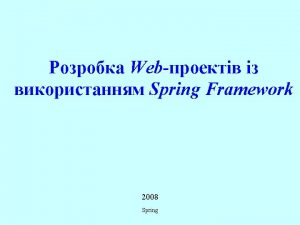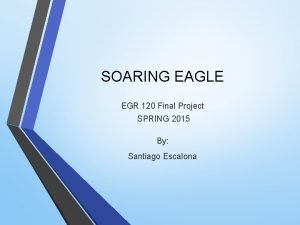EUSC Spring 2014 EGR 102 Update Course Description










![Start Flow Chart xl , xu, Lmin Calculate estimated root: xr = [xl+xu)/2] (xu Start Flow Chart xl , xu, Lmin Calculate estimated root: xr = [xl+xu)/2] (xu](https://slidetodoc.com/presentation_image_h/cb9cce1d26e3a31715a4aa02ccccca2c/image-11.jpg)
![MATLAB function [ root, iterations ] = bisection 2( x. U, x. L, Lmin MATLAB function [ root, iterations ] = bisection 2( x. U, x. L, Lmin](https://slidetodoc.com/presentation_image_h/cb9cce1d26e3a31715a4aa02ccccca2c/image-12.jpg)





- Slides: 17

EUSC Spring 2014 EGR 102 Update

Course Description � Application of systematic approaches to engineering problems. Problem decomposition and identification of a solution approach. Solution using tools such as advanced spreadsheet features and MATLAB. Data representation, curve fitting and analysis. Mathematical modeling of engineering systems. Application of principles through teambased engineering projects. � Prerequisite ◦ (EGR 100 or concurrently*) and ((MTH 132 or concurrently) or (MTH 152 H or concurrently) or (LB 118 or concurrently)) *math ready students are taking EGR 102 1 st due to enrollment issues 100 is in the process of being removed as a pre-erq

EGR 102 Course Learning Objectives Students will be able to: • systematically solve engineering problems by decomposition to determine solution approaches • solve problems using appropriate computational tools • graphically portray data in meaningful manner using spreadsheet programs & advanced computational environments • write programs to solve problems & model systems • interpret & communicate results

Instructional Model � Lecture once a week ◦ Hard copy of homework ◦ Quiz over prior week topic � 2 80 minute labs/week ◦ 1 TA ◦ 2 -3 mentors per lab (goal is ~10 to 1) ◦ Electronic submission for each lab

Enrollment � Fall 2013 ◦ 351 students ◦ 1 lecture section ◦ 10 Lab sections � Spring 2014 ◦ 780 students ◦ 2 lecture sections ◦ 18 Lab sections

Topics Covered in Lecture and Lab Lecture � Conservation Law Cost Engineering Matrix Math � Curve Fitting � � � � Lab � ◦ Gaussian Elimination ◦ Linear Regression ◦ Polynomial Regression � Structured Programing ◦ Flow Charting Root Finding Optimization Numerical Integration ODEs � � Introduction to Excel (4 labs) ◦ ◦ ◦ Basics If functions and nested If functions Solver Matrix Multiplication (MMULT) Trend lines and error bars ◦ ◦ ◦ ◦ Basics Scripts Functions Vectors Plotting Iterative Programming Nested Programming Introduction to MATLAB (14 labs) Project (6 Labs) ◦ Writing Exams, Final wrap up (5 labs) General subject selection is process driven for skill set development

Matching Weeks Lecture Lab � Cost � Engineering ◦ Homework requires both hand calculation and Excel work using intrinsic functions � Matrix Review and Gaussian elimination ◦ Homework emphasizes systematic approach � Bisection and Newton. Raphson Root finding � Excel Basics and Functions MATLAB Introduction lab homework focuses on matrix manipulation Iterative programming application of Newton. Raphson � Nested Programming and functions application is Bisection method �

Cost Engineering � Time value of money � Cost, including incremental, average, sunk, and estimating � Economic analyses � Depreciation

Cash Flow Diagram � All options need to be evaluated at the same ‘time’ ◦ Present worth analysis Present Option 1 Option 2 Option 3 Lecture 02 Worth $1, 000. 00 $641, 057. 64 $1, 227, 826. 51 EGR 102 9

Bisection Method � Root ◦ ◦ finding Good mathematical formulation Specific criteria to follow Algebraic equations Comparison criteria easily understood
![Start Flow Chart xl xu Lmin Calculate estimated root xr xlxu2 xu Start Flow Chart xl , xu, Lmin Calculate estimated root: xr = [xl+xu)/2] (xu](https://slidetodoc.com/presentation_image_h/cb9cce1d26e3a31715a4aa02ccccca2c/image-11.jpg)
Start Flow Chart xl , xu, Lmin Calculate estimated root: xr = [xl+xu)/2] (xu – xl) ‐ Lmin <0 >0 F(xl)*F(xr) >0 <0 xu=xr F(xl)* F(xr)] =0 xl=xr Stop
![MATLAB function root iterations bisection 2 x U x L Lmin MATLAB function [ root, iterations ] = bisection 2( x. U, x. L, Lmin](https://slidetodoc.com/presentation_image_h/cb9cce1d26e3a31715a4aa02ccccca2c/image-12.jpg)
MATLAB function [ root, iterations ] = bisection 2( x. U, x. L, Lmin ) % Inputs: x. U, upper limit of interval %Calculate x. R and % x. R=(x. U+x. L)/2; % x. L, lower limit of interval Lmin, tolerance % Outputs: root, final root after iterating % iterations, number of iterations performed %Calculate f(xr) and f(x. L) %----------------------- f. R=f_5 A(x. R); -------------f. L=f_5 A(x. L); %Evaluate f(xu) and f(xl) by calling function f_5 A %If f. R*f. L is greater than zero, x. L becomes x. R, if it is f. U=f_5 A(x. U); less than zero, f. L=f_5 A(x. L); %x. U becomes x. R. %Display an error message if the interval supplied is not if (f. R*f. L)>0; valid if (f. U*f. L)>0 error(': ( The equation does not cross the xaxis in the interval supplied') end %Initialize counter by setting it equal to zero. Initialize interval length L=x. U-x. L; counter=0; x. L=x. R; else (f. R*f. L)<0; end x. U=x. R; %Update counter=counter+1; end L=x. U-x. L; %Define the outputs %Create the While loop to perform the bisection method root=x. R; iterations=counter; while L>=Lmin

Current Project � Wastewater Treatment Plant: Lift station Pump design ◦ Develop system curves from data ◦ Manipulate given data in Excel, produce file that is imported to MATLAB �Requires use of Excel help for Table look up ◦ Create distinct vectors from imported data ◦ Write code for calculation of head loss �Requires use of MATLAB help for intrinsic 2 nd order polynomial fit ◦ Create plots of system curves to select pump ◦ Annual Cost analysis of pump options


EGR 102 Prior Project � � � Bumper crash analysis Data from local design house Objective: ◦ Maximize energy absorption ◦ Optimize key radii & material thickness � Tasks: ◦ ◦ ◦ Evaluate design at key points Generate & filter force-deflection curves Calculate energy by numerical integration Surface curve fit energy, stroke & stress data Optimize design Co. Re Experience February 27, 2014 15

Overriding Theme � Problem Solving ◦ Thought process ◦ Engineering Approach � Select the best tool for solution ◦ Calculator ◦ Excel ◦ MATLAB

Challenges Course perspective Students perspective � 2 � RAM credit course � Instructional Model ◦ Number of students ◦ Moving away from text ◦ Requiring purchase of MATLAB and Calculator � Computer skills from HS ◦ Range from none to extensive � Transference? of calculator (TI-83) ◦ 25 by 25 matrix inversion � But I can just right click… � You. Tube said… � Wolfram alpha � Academic Dishonesty
 Egr 102
Egr 102 Deferred update and immediate update
Deferred update and immediate update Two technicians are discussing clogged egr passages
Two technicians are discussing clogged egr passages Bme egr
Bme egr Bme egr
Bme egr Egr 101
Egr 101 Hisd spring break 2014
Hisd spring break 2014 Spring, summer, fall, winter... and spring cast
Spring, summer, fall, winter... and spring cast Autumn is yellow winter is white
Autumn is yellow winter is white Apwh course and exam description
Apwh course and exam description Ap physics 1 course description
Ap physics 1 course description English bond t junction
English bond t junction Course title and course number
Course title and course number Chaine parallèle muscle
Chaine parallèle muscle Physics 102
Physics 102 Physics 102 uiuc
Physics 102 uiuc Maendeleo ya fasihi katika mifumo mbalimbali
Maendeleo ya fasihi katika mifumo mbalimbali Kraniesynostose
Kraniesynostose
